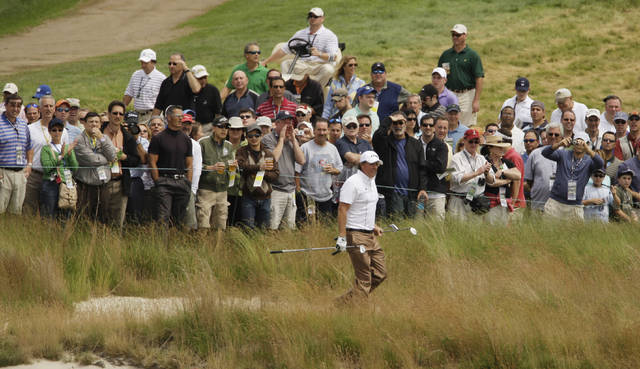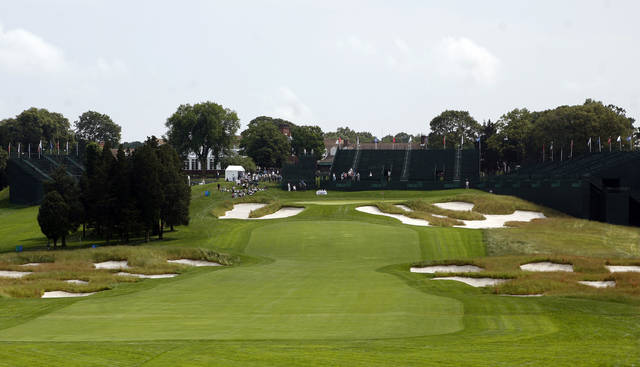

FARMINGDALE, N.Y. (AP) — The warning sign attached to a waist-high iron fence overlooking the first tee is there for a reason. The Black Course at Bethpage State Park is an extremely difficult course, recommended only for highly skilled golfers.
The public course is strong enough to have hosted the U.S. Open twice and now gets a PGA Championship.
In short, Bethpage Black is a beast — all 17 holes of it.
It’s the 18th hole that leaves so much to be desired. The 411-yard closing hole is not a strong par 4 that defines so many major championship courses, like Oakmont or Southern Hills or Merion. It is not a reachable par 5 that can produce two-shot swings at the finish, such as Pebble Beach or Valhalla or Torrey Pines.
It’s really not much of a hole at all.
“I wouldn’t say it’s a bad hole,” Rickie Fowler said. “You have so much going on through the rest of the golf course, and then you kind of just cruise in. Bethpage is just a big golf course. With the 18th hole there it’s like, ‘All right, we’ve put you through enough trouble today.’”
The hole is the second-shortest par 4 at Bethpage Black. It starts on an elevated tee to a narrow fairway that threads a sprawling bunker complex and then heads back up to an elevated green. The landing area was shaped like an hourglass for the U.S. Open in 2002 and 2009. For the PGA Championship, chief championships officer Kerry Haigh plans to keep it the same width to at least give players options to hit driver.
It’s not necessarily an easy birdie hole despite being so short. At the previous two majors, the average score was 4.17, meaning six holes were easier. Miss the fairway and players will have a tough time avoiding bogey.
But it probably won’t be much worse than that, and not much better.
“It’s a strong course. It’s a tough course,” Henrik Stenson said. “But it doesn’t have the strongest or best finishing hole.”
Phil Mickelson made a double bogey on the 18th at Winged Foot that cost him the U.S. Open in 2006, the one runner-up finish that haunts him the most. Making par was such a burden at Whistling Straits in the 2004 PGA Championship that it cost Justin Leonard the title and kept Ernie Els from a playoff. Jordan Spieth and Dustin Johnson, playing a group apart, each faced eagle putts from the 15-foot range to win on the final hole at Chambers Bay in the 2015 U.S. Open.
Now that was drama.
Bethpage Black has a finish remembered for two clubs — 6-iron and 9-iron — that Lucas Glover hit off the tee and onto the green when he won the 2009 U.S. Open.
Some context is required for that day. Because rain had soaked the course all week — it required a Monday finish to get in 72 holes — the USGA moved up the tee so that it played 364 yards. The idea was to give players a chance to hit driver beyond the pinch point of the hourglass shape.
“We had so much rain on Saturday night that the lowest, wettest place was the 18th fairway,” USGA executive director Mike Davis said.
Glover says the reason he hit 6-iron off the tee was to have the same shot he had hit the previous three rounds, when he used 5-wood off the tee. “The goal on the last round was to get it where I had it the rest of the week,” he said.
“I don’t think it’s a bad hole,” Glover said. “It’s tight. It’s a cool-looking hole. If you don’t get it on the fairway, it’s a bear. If you get it on the fairway, there’s not much to it, which is fair with the rest of the course.”
That would be the defense of No. 18 that Mickelson applies.
Mickelson, a runner-up in the last two majors held at Bethpage Black, loves the finishing stretch more than just the finishing hole. The par-5 13th can be reached in two for long hitters. The 14th is 161 yards, making it the shortest hole on the course and a reasonable birdie chance. And then players cross the road and face the strongest hole at No. 15, which plays 484 yards with a severe dogleg that goes up the hill.
The 16th hole is no picnic, and neither is the par-3 17th.
“It’s a good mixture to catch guys with birdies on 13 and 14, and to catch guys with pars on 15, 16 and potentially 17,” Mickelson said. “You can make up ground on the closing holes, and then 18.”
And what to make of 18?
“That’s one hole that gets you back home,” Mickelson said, comparing it in that regard with the 18th at Cypress Point. “It doesn’t showcase really how great the entire golf course is. The closing hole isn’t the best hole out there, but it gets you back.”
It’s not the shortest closing hole in championship golf. The 18th at St. Andrews is 356 yards protected by out of bounds on the right and the Valley of Sin in front of the green. But most players can drive the green. The 18th at Olympic Club in San Francisco is 344 yards, but the tee shot is partially blind and the green complex is so severe that birdie is no bargain even with a wedge to the green. Miss the fairway and par becomes a challenge.
The closing hole at Bethpage is so ordinary that Davis contemplated using the 18th hole on the adjacent Red Course for the U.S. Open, but left it as it was. Among other reasons, it allowed people to play the same routing as a U.S. Open. That’s the beauty of playing majors on public golf courses.
For major championship golf or public play, the heavy lifting takes place over 17 holes.
“You’ve done all your work. The meat of the golf course is in the middle,” Fowler said. “And then 18 is like, ‘Thanks for coming. Hope you had fun.’”



